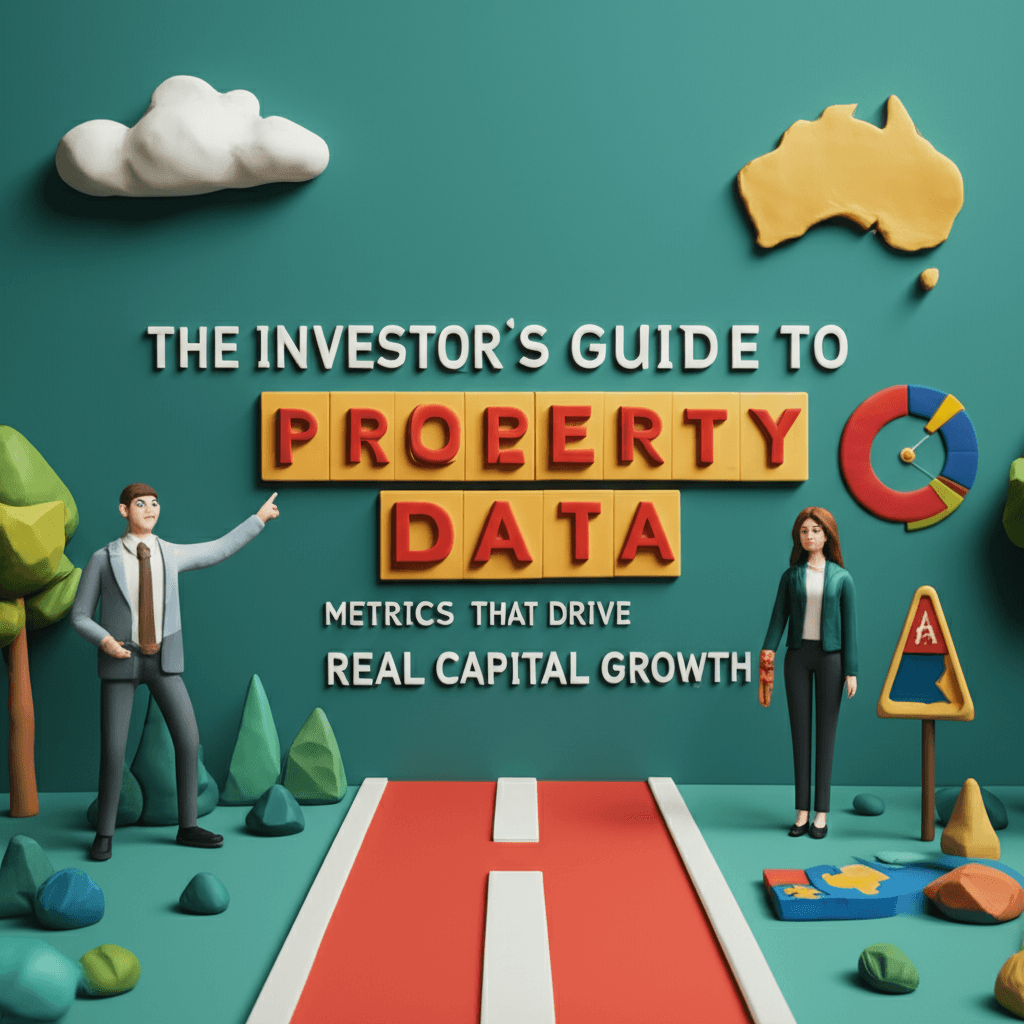The Investor's Guide to Property Data: Metrics That Drive Real Capital Growth
Learn to distinguish between vanity metrics and the crucial data points that underpin long-term property investment success in Australia.

Introduction
Navigating the Australian property market in mid-2025 can feel overwhelming. You're bombarded with conflicting advice, sensationalist headlines, and so-called 'hotspotting' reports that promise the world. Many investors get caught up in barbecue talk about positively geared properties and tax deductions, often losing sight of the one metric that truly builds wealth: capital growth. The truth is, a tax deduction is merely a discount on an expense; it never makes you money. Real, sustainable wealth is built when the value of your asset grows significantly over time.
This guide cuts through the noise. We'll break down the essential data metrics you should be focusing on, expose the common myths that lead investors astray, and provide a clear framework for making decisions backed by evidence, not hype. Whether you're analysing a booming suburb, assessing future supply, or deciding on your next portfolio move, understanding the right data is your greatest advantage.
The Greenfield Dilemma: A Case Study in Supply and Demand
New land and house packages, often called 'Greenfield estates', can be incredibly tempting for investors. They promise shiny new homes with high depreciation benefits and strong rental appeal. However, they carry significant, often hidden, risks that can stifle capital growth for years.
Let's analyse a common scenario: a suburb like Treeby in Perth, which has seen 40% growth over three years but is surrounded by developable land. While early investors may have profited, buying in later stages presents a classic investment trap.
Key Risks of Greenfield Estates
Continuous Future Supply: The biggest threat to capital growth is oversupply. Use Google Maps to visually inspect the surrounding area. If you see vast tracts of vacant, undeveloped land, it's a major red flag. This land represents a future pipeline of properties that will compete directly with yours, keeping a ceiling on price growth.
Low Land-to-Asset Ratio: On a brand-new property, a huge portion of the purchase price goes to the developer's and builder's margins. The underlying land value—the component that appreciates most—is relatively small. For superior long-term growth, you want to target established properties where the land makes up a much higher percentage of the total value. We recommend avoiding properties less than 20 years old, and preferably over 40, to ensure depreciation has washed out and land value is maximised.
Questionable Build Quality: Volume builders in these estates are focused on speed and profit. This can often lead to the use of subcontractors and cheaper materials, resulting in builds that may not stand the test of time compared to older, more solidly constructed homes.

Essential Data for Vetting Any Suburb
Instead of being lured by new builds, a savvy investor uses data to find value in established surrounding areas. This is where powerful [real estate analytics](https://houseseeker.com.au/features/real-estate-analytics) become indispensable.
Stock on Market (SOM) Percentage: This is a critical indicator of current supply versus demand. It's calculated by dividing the number of properties for sale by the total number of dwellings in the suburb. In a balanced market, you might see 2-3%. In today's undersupplied market (early 2025), a healthy SOM is often below 1.5%, with top-performing areas frequently sitting under 1%. A high SOM (e.g., 4% or more) signals an oversupplied market where buyers have the upper hand.
Vacancy Rates: This metric tells you about rental demand. A low and falling vacancy rate (ideally below 1.5%) indicates strong tenant demand, which supports rental income and attracts other investors. Be cautious of markets where buyers' agents are buying in droves; this can cause vacancy rates to spike as investor-owned properties flood the rental market simultaneously.
Dwelling Count: When analysing growth figures, always check the suburb's total dwelling count. A suburb with only 300 houses can have its median price skewed by a few high-value sales, showing misleading growth of 95%. Suburbs with thousands of dwellings (e.g., 2,000+) provide more reliable and consistent data.
Vanity Metrics vs. Valuable Indicators: Debunking Common Myths
Many investors base decisions on widely accepted 'rules' that have little statistical correlation with capital growth. Here are some of the most common myths to ignore:
Myth 1: Proximity to the CBD is Key: The idea that properties closer to the city centre always perform better is outdated. While some inner-city markets perform well, countless suburban and regional areas have outperformed them due to different growth drivers like lifestyle, affordability, and local infrastructure.
Myth 2: 'Blue Chip' Suburbs are a Safe Bet: The 'blue chip' label is subjective and often just means 'expensive'. These markets can experience long periods of stagnation. True investment potential is found by analysing current supply and demand dynamics, not relying on a brand name.
Myth 3: Population Growth Drives Property Prices: At a macro level (national), population growth is a fundamental driver. However, at the suburb level, it's often a stronger indicator of new supply (more people moving into new housing estates) than organic demand. Don't base a micro-level investment decision on this metric alone. You can explore broader demographic trends via sources like the [Australian Bureau of Statistics (ABS)](https://www.abs.gov.au/statistics/people/population), but use suburb-specific data for your final analysis.
Myth 4: High Wage Growth is a Prerequisite: Like population growth, this sounds logical but the data doesn't show a strong correlation at the suburb level. Other factors, like supply constraints and local demand, are far more predictive.

The Reality of a Portfolio: Costs, Cash Flow, and Crossroads
YouTube channels and property gurus often paint a picture of effortless wealth creation. The reality is that property investing is a business, and it comes with significant costs, stress, and cash flow challenges that are rarely discussed.
Understanding Your True Net Position
The gross yield advertised on a property listing is a fantasy figure. Your actual return, or net yield, is what's left after all expenses. These include:
Fixed Costs: Council rates, water rates, strata levies (if applicable), land tax, and property insurance.
Variable Costs: Repairs, maintenance, property management fees, and loan fees.
Interest Rates: This is the single biggest expense, and rising rates can quickly turn a positively geared property into a negative one, requiring you to fund the shortfall from your own pocket each month.
An average net yield, before accounting for your loan interest, might only be 2-3%. It is the capital growth that must do the heavy lifting to make the investment worthwhile.
Case Study: To Buy Again or Consolidate?
Consider an investor in their mid-30s with a solid portfolio but maxed-out borrowing capacity. They face a common dilemma: stretch financially to buy a fourth property, or play it safe and pay down debt, enjoying a risk-free 7% return in their offset account?
There's no single right answer; it depends entirely on your personal circumstances and goals.
The Aggressive Approach: If you have a secure income, a large cash buffer, and a long investment horizon, using leverage to acquire another growth asset could be the right move. The goal is to achieve a return on investment (ROI) that far exceeds the 7% offset return, perhaps targeting 20% or more through capital growth.
The Conservative Approach: If you are nearing retirement, looking to reduce financial stress, or your cash flow is already tight, pushing your borrowing capacity is risky. A rate rise could put you under immense pressure. In this case, consolidating, paying down non-deductible debt on your home, and enjoying the guaranteed return from your offset account is a perfectly valid and sensible strategy.
This decision requires a deep understanding of your financial position and risk appetite. A tool like an [AI Buyer's Agent](https://houseseeker.com.au/features/ai-buyers-agent) can help model these scenarios, providing personalized recommendations based on your unique goals and financial data.
Conclusion
Successful property investing in 2025 is not about following the crowd or relying on outdated rules of thumb. It's about becoming a disciplined analyst who can separate signal from noise. By focusing on the core drivers of capital growth—primarily tightly held supply and strong, measurable demand—you can build a portfolio that stands the test of time.
Remember to prioritise capital growth above all else, use granular [real estate analytics](https://houseseeker.com.au/features/real-estate-analytics) to vet every opportunity, be wary of the siren song of new developments in oversupplied areas, and always align your investment strategy with your personal financial capacity and life goals.
Ready to move beyond guesswork? Dive deep into the numbers and uncover high-potential investment areas with HouseSeeker's advanced [real estate analytics](https://houseseeker.com.au/features/real-estate-analytics). Start making data-backed decisions today.
Frequently Asked Questions
What is a good 'stock on market' percentage for an investor?
A low stock on market (SOM) percentage is a strong indicator of high demand and low supply. In the current market, an excellent SOM is typically below 1%, while anything under 1.5% is generally considered healthy for investment. A figure above 3% suggests a market with more sellers than buyers, which may limit price growth.
Why is a high land-to-asset ratio important for capital growth?
The building on a property depreciates over time, while the land underneath it typically appreciates. A high land-to-asset ratio means a larger portion of your investment is in the appreciating component (the land). This is why older, established homes in well-located, built-out areas often experience superior long-term capital growth compared to new builds where the building makes up a large part of the value.
Can I find a property based on lifestyle factors, not just data?
Absolutely. While data is crucial for identifying high-growth potential areas, the right property for you also needs to meet specific lifestyle needs, whether for yourself or for attracting the right tenants. HouseSeeker's [AI Property Search](https://houseseeker.com.au/features/ai-property-search) allows you to combine both, using natural language to search for homes based on factors like 'close to good cafes', 'walking distance to a train station', or 'in a top school catchment', all within data-vetted suburbs.
